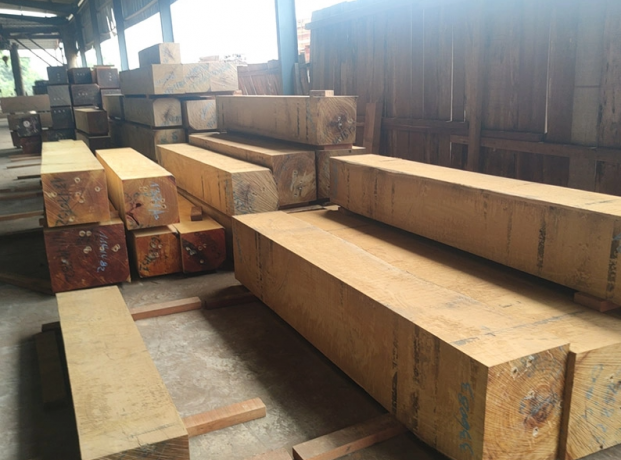please click here:
https://www.shdtimber.com/products-p3.html
Afrormosia, scientifically known as Pericopsis elata, is a hardwood native to the tropical forests of West and Central Africa. Often dubbed "African Teak," this timber has gained popularity as a sustainable and aesthetically pleasing alternative to traditional teak (Tectona grandis). Despite its resemblance to teak in appearance and properties, Afrormosia is a distinct species with unique characteristics that make it highly desirable in modern woodworking, furniture, and luxury interiors.
With global awareness of sustainable forestry growing, Afrormosia has emerged as a premium hardwood option that balances beauty, performance, and environmental responsibility.
Historical Context: Afrormosia's Role in African Timber Trade
Afrormosia has a long-standing history in Africa's timber industry. Traditionally, it was harvested by local communities for constructing boats, bridges, and high-end furniture. Its workability and natural durability made it a preferred choice in both domestic and international markets. During the colonial period, Afrormosia was exported to Europe, where it became a prized wood for flooring, cabinetry, and veneers.
In recent decades, rising global demand for teak and other tropical hardwoods put pressure on sustainable sourcing. Afrormosia's inclusion in the CITES Appendix II list highlights the need to manage trade responsibly, ensuring that its extraction does not endanger the species or its ecosystem.
Aesthetic Appeal: The Beauty of Afrormosia
Afrormosia boasts a rich golden-brown hue with dark veining, giving it a luxurious appearance. Its fine, uniform texture and natural luster make it highly sought after for high-end furniture, cabinetry, flooring, and interior finishes. The wood's straight grain often features subtle ribbon striping, adding a sophisticated visual texture that enhances luxury designs.
Color and Grain Variations
-
Heartwood: Rich golden-brown to deep reddish-brown with darker streaks.
-
Sapwood: Lighter yellowish-brown, clearly demarcated from the heartwood.
-
Grain Patterns: Usually straight, occasionally interlocked, with fine to medium texture.
Afrormosia's aesthetic flexibility allows designers to match it with contemporary, minimalist, or traditional interior styles, making it highly versatile.
Physical Properties: Strength, Durability, and Workability
Afrormosia is renowned for its combination of strength and resilience. It is a dense hardwood, comparable to teak, making it resistant to wear, impact, and deformation. Its physical properties include:
-
Density: Approximately 0.8 g/cm³, providing excellent stability.
-
Durability: Highly resistant to fungal decay and termite attacks, classified as very durable under European standards.
-
Hardness: Suitable for flooring, staircases, and high-traffic areas.
Workability
Afrormosia responds well to both hand and machine tools. Its moderate workability allows for fine detailing, smooth sanding, and precise joinery. Unlike some tropical hardwoods, it rarely blunts tools excessively, though pre-drilling for nails and screws is recommended.
Sustainability and Ethical Considerations
As a valuable tropical hardwood, Afrormosia faces sustainability challenges. Overharvesting and habitat loss have contributed to population declines in its native range. Responsible sourcing is therefore crucial.
-
CITES Listing: Afrormosia is listed in Appendix II, requiring controlled trade permits to ensure legal and sustainable extraction.
-
Forest Stewardship: Certified forestry initiatives in Ghana, Cameroon, and the Democratic Republic of Congo promote sustainable harvesting practices.
-
Market Impact: Ethical sourcing can command premium prices while protecting ecosystems and local communities.
Investing in sustainably sourced Afrormosia supports biodiversity, combats illegal logging, and helps preserve African tropical forests for future generations.
Afrormosia vs. Teak: A Comparative Overview
| Feature | Afrormosia | Teak |
|---|---|---|
| Origin | West and Central Africa | South and Southeast Asia |
| Color | Golden-brown with dark veining | Golden-brown to dark brown |
| Grain Pattern | Straight with occasional ribbon stripes | Straight to interlocked |
| Durability | Highly durable | Highly durable |
| Workability | Moderate | Moderate to easy |
| Cost | Generally more affordable | Generally more expensive |
| Sustainability | Controlled trade under CITES | Concerns over over-exploitation |
While both woods offer durability and elegance, Afrormosia's slightly lower price point and ethical sourcing make it an attractive alternative to teak. Designers seeking luxury aesthetics without compromising environmental responsibility often prefer Afrormosia.
Applications: Where Afrormosia Shines
Afrormosia's versatility makes it suitable for a broad range of applications:
-
Furniture: Chairs, tables, cabinets, and custom pieces benefit from the wood's richness and stability.
-
Flooring: Its hardness and durability withstand heavy foot traffic in commercial and residential spaces.
-
Cabinetry and Millwork: Precision joinery and smooth finishing highlight Afrormosia's natural beauty.
-
Veneers: Used in high-end furniture and automotive interiors, providing a luxury wood finish at reduced cost.
-
Exterior Applications: Properly treated, Afrormosia can serve as decking, window frames, and outdoor furniture.
Care and Maintenance: Ensuring Longevity
Afrormosia's longevity depends on proper maintenance:
-
Regular Cleaning: Dust and wipe with a damp cloth to prevent buildup of dirt and grime.
-
Protective Finishes: Oils, varnishes, or wax coatings enhance resistance to moisture and UV exposure.
-
Avoid Abrasives: Harsh chemicals or scrubbing pads can damage the wood's natural sheen.
-
Humidity Control: Maintain stable indoor humidity to prevent warping or cracking.
When cared for properly, Afrormosia furniture and flooring can last decades while retaining its natural beauty.
Market Trends: Afrormosia in Modern Design
As sustainability becomes a key factor in purchasing decisions, Afrormosia is gaining traction among architects, interior designers, and furniture manufacturers:
-
Luxury Furniture: Premium brands increasingly offer Afrormosia options as eco-friendly alternatives to teak.
-
Architectural Projects: Hotels, restaurants, and high-end residential buildings use Afrormosia for flooring, wall panels, and cabinetry.
-
Global Trade: Africa, Europe, and North America represent the largest markets, with demand driven by both aesthetics and sustainability.
Innovations in Afrormosia Usage
Recent innovations include engineered Afrormosia products such as laminated boards, veneers, and pre-finished flooring. These reduce waste, optimize durability, and allow for creative design applications. The use of Afrormosia in hybrid wood products also provides an environmentally responsible alternative for large-scale projects.
Conclusion: Embracing Afrormosia
Afrormosia offers a compelling combination of luxury, strength, and environmental responsibility. Its golden-brown aesthetics, resilience, and versatility make it an excellent choice for furniture, flooring, cabinetry, and exterior projects. By supporting responsibly sourced Afrormosia, consumers enjoy premium wood products while contributing to sustainable forestry practices. The growing global appreciation for eco-conscious luxury underscores Afrormosia's role as the “African Teak” of choice.
Frequently Asked Questions
1. What is Afrormosia wood?
Afrormosia (Pericopsis elata) is a hardwood native to West and Central Africa, often called "African Teak" due to its similar appearance and properties.
2. Is Afrormosia sustainable?
Afrormosia is listed in CITES Appendix II, indicating regulated trade to prevent over-exploitation. Certified forestry practices help ensure sustainable sourcing.
3. How does Afrormosia compare to teak?
Afrormosia is highly durable and visually similar to teak but is generally more affordable and has unique grain variations that add character.
4. What are the common uses of Afrormosia?
It is widely used in furniture, flooring, cabinetry, veneers, and certain exterior applications like decking and window frames.
5. How should Afrormosia be maintained?
Regular cleaning with a damp cloth, protective finishes, and avoiding harsh chemicals or abrasive tools will maintain its beauty and durability.
6. Can Afrormosia be used outdoors?
Yes, with proper sealing and finishing, Afrormosia can withstand outdoor conditions but requires occasional maintenance to prevent weathering.
7. Why is Afrormosia considered eco-friendly?
Responsible sourcing and CITES regulation prevent overharvesting, supporting sustainable forestry while protecting biodiversity.
Article Summary
Afrormosia (Pericopsis elata), known as African Teak, is a sustainable hardwood prized for its golden-brown color, durability, and versatility. Its controlled sourcing and premium aesthetics make it ideal for furniture, flooring, cabinetry, and exterior applications, offering eco-conscious luxury for modern design.






